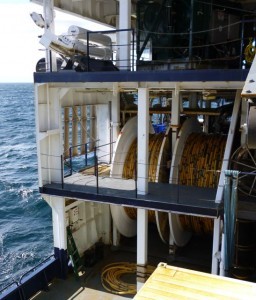Just two hours after taking on our new personnel, we started deploying seismic gear – a very quick transition! Our seismic streamers are stored on gigantic spools, which unreel cable off the back of the ship into the ocean. A large buoy is affixed to the end of the streamer, and ‘birds’ are attached along its length, which can be used to control the depth of the streamer. Large paravanes hold the streamers apart; these are like large kites flying in the water off the back corners of the ship.
Deploying miles of streamer and the other attending gear is an impressively long and complicated undertaking. We started over two days ago, and have been working around the clock in shifts ever since. Many repairs and adjustments are made to the gear as it’s deployed. The streamer is divided into 150-m-long sections connected by modules; both sections and modules can fail and need to be replaced. Replacing a 150-m-long section of cable is an arduous task involving major manual labor by teams of ~5-6 people. But we are nearing the finish line; as I write, the last kilometer of the second streamer is going over the back of the boat. Fingers crossed that the deployment will soon be complete and the data collecting can begin!



